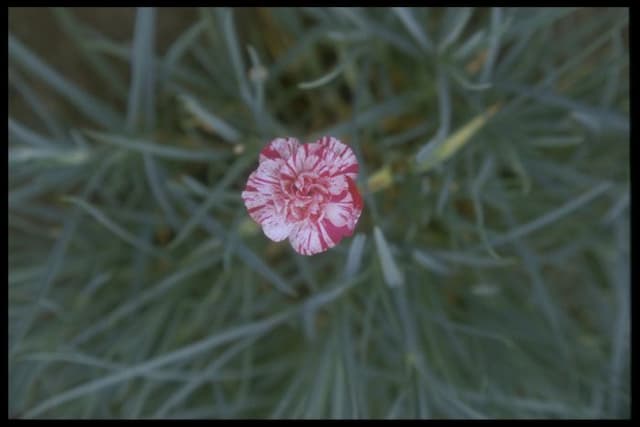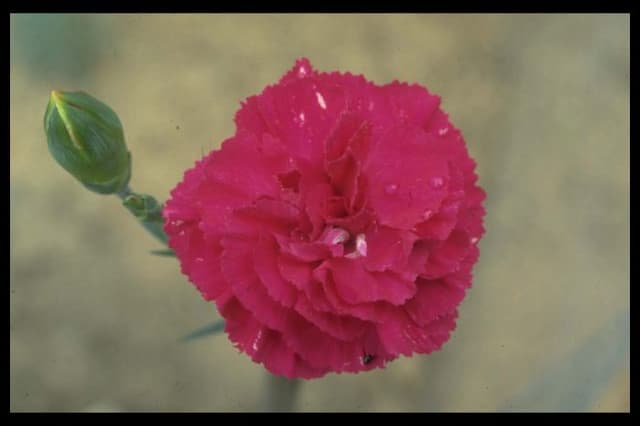Carnation Dianthus 'Whatfield Magenta' (p)

ABOUT
The Dianthus 'Whatfield Magenta' is a striking plant known for its vibrant magenta flowers. The blooms are rich in color, with a hue that stands out in any garden. Each flower consists of five petals, which are often fringed or have serrated edges, giving them a unique and intricate appearance. These petals sometimes showcase a subtle pattern or variation in color intensity, adding depth and complexity to the overall look of the flower. The blooms emit a pleasant, spicy fragrance that can attract passersby and beneficial insects alike. The flowers are held aloft on sturdy stems that rise from a neat mound of narrow, green leaves. The foliage is typically grayish-green to blue-green and has a grass-like texture, forming a complementary backdrop to the showy flowers. The leaves are slender and may be slightly rolled or have a linear shape, contributing to the plant's overall compact and tidy form. The Dianthus 'Whatfield Magenta' typically blooms in spring and can carry on its flowering display into the summer, offering a long season of interest. It's a popular choice for borders, rock gardens, and containers due to its vibrant color and charming form.
About this plant
 Names
NamesFamily
Caryophyllaceae
Synonyms
Pinks, Carnations, Sweet William
Common names
Dianthus 'Whatfield Magenta'
 Toxicity
ToxicityTo humans
Carnation, which Dianthus 'Whatfield Magenta' falls under, is generally not considered toxic to humans. There are no well-documented cases of carnation poisoning in humans, and it is not known to cause serious harm if ingested in small quantities. However, ingesting any part of the plant might cause mild stomach upset in some individuals. It is always best to err on the side of caution and not consume parts of ornamental plants unless they are known to be edible.
To pets
Carnation, which Dianthus 'Whatfield Magenta' falls under, is similarly not considered highly toxic to pets. However, if a pet ingests a significant amount of the plant, it could potentially experience mild gastrointestinal upset, such as vomiting or diarrhea. As with humans, it is advisable to prevent pets from eating ornamental plants to avoid any potential health issues.
 Characteristics
CharacteristicsLife cycle
Perennials
Foliage type
Evergreen
Color of leaves
Blue-green
Flower color
Magenta
Height
1 foot (30 cm)
Spread
1 foot (30 cm)
Plant type
Herb
Hardiness zones
5
Native area
Europe
Benefits
 General Benefits
General Benefits- Aesthetic Appeal: Adds vibrant magenta color to gardens and landscapes with its attractive blooms.
- Ease of Care: Low-maintenance requirements make it suitable for various gardeners, including beginners.
- Drought Tolerance: Once established, it can withstand periods of low water, making it ideal for water-efficient gardens.
- Long Blooming Period: Provides a long-lasting display of flowers often from late spring through summer.
- Attracts Pollinators: Bees and butterflies are drawn to the blossoms, which helps pollinate other plants.
- Versatility: Suitable for borders, rockeries, containers, and as ground cover, offering various landscaping uses.
- Fragrance: The flowers can emit a pleasant scent, adding a sensory dimension to gardens.
- Compact Growth: Its neat growth habit makes it an appropriate choice for small gardens and spaces.
- Cold Hardy: Capable of withstanding cooler temperatures, which makes it suitable for various climates.
- Cut Flower Use: The blossoms can be cut and used in floral arrangements, adding indoor decoration value.
 Medical Properties
Medical PropertiesThis plant is not used for medical purposes.
 Air-purifying Qualities
Air-purifying QualitiesThis plant is not specifically known for air purifying qualities.
 Other Uses
Other Uses- The petals of Dianthus can be crystallized and used as edible decorations for cakes and desserts, adding a splash of natural color and a unique floral taste.
- Dianthus flowers are used in the art of pressed flowers to create natural artworks and bookmarks due to their vibrant colors and flat-lying petals.
- Dried Dianthus petals can be incorporated into homemade potpourri mixes to add a soothing fragrance to your living space.
- The vibrant colors of Dianthus petals can be used to naturally dye fabrics or yarns, giving them a beautiful and subtle hue.
- Dianthus blossoms are sometimes used in salads for a pop of color and a slightly spicy or clove-like flavor reminiscent of their fragrance.
- These flowers can serve as a natural pest deterrent in the garden since some pests are repelled by their scent.
- In some cultures, Dianthus is used to decorate traditional costumes or ceremonial dresses, symbolizing love and affection.
- Homemade scented inks for calligraphy or art projects can be infused with the essence of Dianthus petals.
- Dianthus plants can be used as a natural floral confetti at events like weddings, providing a biodegradable and eco-friendly alternative.
- These flowers are used in crafting natural dyes for Easter eggs, imparting a range of colors from light pinks to deep magentas.
Interesting Facts
 Feng Shui
Feng ShuiThe Dianthus, commonly known as Carnation, can be used in Feng Shui to attract love and healing energy due to its vibrant flowers and pleasant fragrance. Place them in the Southwest area of a home or garden to enhance relationships or in the East to promote health and family harmony.
 Zodiac Sign Compitability
Zodiac Sign CompitabilityThe Carnation is not used in astrology practice.
 Plant Symbolism
Plant Symbolism- Love: Dianthus flowers are often associated with love due to their vibrant colors and longstanding use in floral arrangements.
- Passion: The rich magenta hue of the 'Whatfield Magenta' variety specifically symbolizes deep affection and intense emotional connections.
- Admiration: Gifting these flowers can indicate admiration and a high regard for someone, acknowledging their virtues and qualities.
- Distinction: The unique color and pattern of Dianthus 'Whatfield Magenta' stand for distinctiveness and celebrating what makes someone or something special.
- Boldness: The striking appearance of this plant is often seen as a symbol of boldness and daring, encouraging us to take risks and be courageous.
 Water
WaterPinks, including Dianthus 'Whatfield Magenta', prefer to be watered regularly but with moderation to maintain slightly moist soil. Watering should be done deeply to encourage root growth, approximately one inch of water either through rainfall or manual watering per week is appropriate. During hot, dry spells, a supplemental watering may be necessary. It's important to avoid overhead watering to prevent foliage diseases, instead, water at the base of the plant. Overwatering or allowing the plant to sit in waterlogged soil can lead to root rot, so ensure that the soil is well-draining.
 Light
LightPinks thrive best in full sun, which means they require at least six hours of direct sunlight daily. Planting Dianthus 'Whatfield Magenta' in a spot that gets ample morning light and some protection from the intense afternoon sun can help to maintain vibrant bloom colors. Select a location where the plant will receive unfiltered sunlight for the majority of the day for optimal growth.
 Temperature
TemperaturePinks are relatively hardy and Dianthus 'Whatfield Magenta' can withstand cold down to about 20°F, though it prefers the temperature to be between 60°F and 70°F for robust growth. It can survive up to 85°F but may need protection from intense heat. It's important to avoid extreme temperature fluctuations and to provide mulch for root protection during colder months.
 Pruning
PruningPruning Pinks is essential for maintaining a robust and aesthetically pleasing plant. For Dianthus 'Whatfield Magenta', deadheading spent flowers will encourage further blooming throughout the season. Pruning back the foliage in early spring or after the first flush of blooms can help to rejuvenate the plant and promote denser growth. The best time for a major trim is after the main blooming period in summer or early fall.
 Cleaning
CleaningAs needed
 Soil
SoilCarnations prefer well-draining, loamy soil with a pH between 6.0 and 7.5. A mix of two parts garden soil, one part peat moss, and one part perlite or coarse sand can create an ideal environment for 'Whatfield Magenta' carnations to thrive and prosper.
 Repotting
RepottingCarnations, like the 'Whatfield Magenta', typically don't need frequent repotting and should be repotted once every 2-3 years or when they seem to outgrow their current container. It's best to do this in the spring before new growth begins.
 Humidity & Misting
Humidity & MistingCarnations, including the 'Whatfield Magenta' variety, usually prefer average to low humidity levels. They thrive best in conditions where the humidity does not exceed 50%, which typically matches the average indoor environment, making additional humidity control unnecessary.
 Suitable locations
Suitable locationsIndoor
For 'Whatfield Magenta' carnations, use bright, indirect light and well-draining soil indoors.
Outdoor
Plant 'Whatfield Magenta' carnations in full sun to part shade and well-drained soil.
Hardiness zone
3-9 USDA
 Life cycle
Life cycleDianthus 'Whatfield Magenta', commonly known as 'Whatfield Magenta' Pink, begins its life cycle when seeds are sown in early spring to late winter under glass or in late spring directly into well-drained soil. These seeds germinate, typically within 7-14 days under optimal conditions, and seedlings emerge to develop true leaves. The young plants then grow and establish a strong root system. As they mature, 'Whatfield Magenta' produces a basal rosette of narrow, green leaves from which flower stems rise, blooming prolifically with magenta flowers from late spring to early summer and often again in the fall if deadheaded regularly. After the blooming period, the plant may produce seed pods if flowers are not removed, allowing for self-seeding or seed collection for future propagation. With proper care, including regular watering and occasional feeding, Dianthus 'Whatfield Magenta' is a perennial plant that can last for several years in the garden, each year going through a period of dormancy in winter before restarting its cycle in the spring.
 Propogation
PropogationPropogation time
Spring-Early Summer
Dianthus 'Whatfield Magenta', commonly known as Pinks, is typically propagated through cuttings. The most popular method is to take non-flowering shoots during late spring or early summer. These cuttings, about 2 to 4 inches (5 to 10 centimeters) in length, should be taken from fresh growth and ideally with a heel of the older plant material still attached. After cutting, they are usually placed in a well-drained propagating mix and provided with consistent moisture and warmth. Rooting generally occurs within a few weeks, and once established, these new plants can be transplanted into individual pots or directly into the garden.




![Pink [Coconut Sundae]](/_next/image?url=https%3A%2F%2Fplants-admin.emdemapps.com%2Fimages%2Fplants%2F%2Fimages%2F604b5d09d4fd1.png&w=640&q=75)




